History about Kungsgården and Ovansjö
The original Ovansjö
The highest parts of the landscape in Ovansjö rose from the sea around some 6000 years ago. It was probably at this time that the first hunter gathers arrived in the region. Geologists and arceologists however date the first settlement in this region back to around 3000 BC. Stone axes and arrowheads originating from that time (the transition between the old and young stone age) have been found. No archaeological finds have been found in this region between the later part of the Stone Age and late Iron Age (around 500 BC). The reason for this is probably the deterioration of the climate that the country was exposed to during the transition between the Bronze- and Iron Age, the period called the fimbulwinter.
During Roman times and the time of the Great Migration (the time between the birth of Christ and 600 AD) was an extensive period for settlement in the county of Gästrikland. Ovansjö was already at that time a central part of the county in population- as well as economical terms.
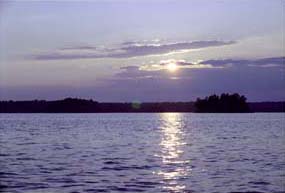 The
name Ovansjö originates from the two Swedish words for "above"
and "lake" (ovan and sjö), the district above the big lake,
Storsjön. Further down in the text you can read about the origin
of the name Kungsgården.
The
name Ovansjö originates from the two Swedish words for "above"
and "lake" (ovan and sjö), the district above the big lake,
Storsjön. Further down in the text you can read about the origin
of the name Kungsgården.
The production of iron started in the county of Gästrikland around two thousand years ago. Piles of iron slag from the Viking age has been found in all parishes in Gästrikland. Ovansjö was originally the largest parish and meeting place in Gästrikland. During Sweden's medieval period there were around 170 villages in Ovansjö .
 The
forests in Ovansjö were of high value as grazing land for the animals,
hunting ground and fuel for the households. The agriculture was the most
important issue for the farmers of the land. To tackle the food supply
people had many animals. It was necessary to have many horses for transportation
outside the farm areas. It was also necessary to utilize the land's natural
resources. The animals were kept for feeding on the fields around the
farms during the summer. Grain was the main crop. During difficult times
the flour had to be mixed with bark from the trees. The value of the forests
rose when man started to mine and work the iron ore from the bogs. Ovansjö
had natural resources for the making of iron. There were large swamps
from which the iron ore was collected.
The
forests in Ovansjö were of high value as grazing land for the animals,
hunting ground and fuel for the households. The agriculture was the most
important issue for the farmers of the land. To tackle the food supply
people had many animals. It was necessary to have many horses for transportation
outside the farm areas. It was also necessary to utilize the land's natural
resources. The animals were kept for feeding on the fields around the
farms during the summer. Grain was the main crop. During difficult times
the flour had to be mixed with bark from the trees. The value of the forests
rose when man started to mine and work the iron ore from the bogs. Ovansjö
had natural resources for the making of iron. There were large swamps
from which the iron ore was collected.
Ore and Iron
Iron minerals which has been stored in gravel- and sand layers and travelled with streams to the swamps, were dissolved by acids, then sank to the bottom of the swamps where they were transformed to hard pieces of ore. The ore was mined from the boggy areas and left to dry. When it had dried it was transported to the smelting furnace. The original furnaces were very primitive and consisted of a hole in the ground, covered with burning wood. The smelting furnaces became larger and were built by a stream so that the blast, making the draught, could operate by support from the waterpower. Dry wood was placed as a base in the furnace. When the furnace was heated, a few scoops of ore were thrown into the heat. The ore melted resulting in a fragment that was taken to a forge and worked into forgeable iron. The lakes Storsjön and Näsbysjön were important for transporting the iron, especially during the winter when it could be carried on the ice.
13th century and the name Kungsgården
The name Kungsgården was first mentioned in texts in 1293. Kungsgården's original name was Wijbol, which was later shortened to Wi. The word Wi, at that time, meant a place at which sacrifice was carried out. During the Middle Ages a mansion was constructed in each Swedish county in order that the monarch, on their royal travels, would have suitable accommodation. This estate was in Swedish called Kungsgården (the King's estate). The King had many of these mansions around the country and in Ovansjö it gave name to the main village.
16th century and the villages of Ovansjö
During the middle ages bog ore was abandoned and rock ore became of greater importance. The so called rock men were established instead of the bog ore smelters. Rock men were farmers who also owned shares in mines, foundries and smithies. The rock men region in the west of Gästrikland expanded during the later part of the 16th century from the village of Torsåker and included Ovansjö, Högbo and Järbo. The village of Årsunda was also bonded to Ovansjö by what was called an annex parish.
In April 1521 Ovansjö had a Royal visit by King Gustaf Vasa. In memory of his visit a memorial stone, the Vasa stone, was erected 400 years later next to the church in Ovansjö.
During the middle ages books were kept for taxation of the region's iron resources. In the taxation report from 1543 one could read that Ovansjö included 22 large villages. Among these villages many of them had names connected to the nature. Some names of the villages were Berg, Lem, Mom, Myra, Nor, Näs, Se, Sund, Vall, Vik and Åsen which if translated means for example "the mountain", "the isthmus" and "the ridge". Most of the villages have kept their original names while some have changed slightly. In all probability these villages descend from the time of the Great Migration. Among these villages was also a village that since has disappeared. The village Syl was supposedly situated on the border between the areas Österberg and Övermyra. Many believed that the village Syl had disappeared by the 15th century, which has subsequently been proved wrong since it has been mentioned in several texts from 1620 and thereafter. Other villages were in areas in which probably the first people settled to farm on the rich soil from the clayey bottom of the glacial sea. These three villages in Ovansjö are Hillsta, Grimsta (the Vicarage) and Åttersta. The tax from the villages, was paid during the middle ages by pieces of iron in units known as "osmunds". An osmund weighed around 0,35 kg (around 12 ounces).
17th century
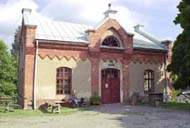 Åttersta,
by the river Borrsjöån, was uzed by the rock men when a foundry
was built around 1570 to take advantage of the water power. The
foundry was in operation until 1868 and in this region tax
was still paid by "osmunds".
Åttersta,
by the river Borrsjöån, was uzed by the rock men when a foundry
was built around 1570 to take advantage of the water power. The
foundry was in operation until 1868 and in this region tax
was still paid by "osmunds".
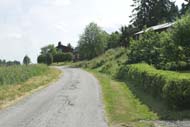 A bit later another works was built
in the area of Norrberg.
The work of the rock men created a wealthy society. There was plenty of
coal for heating the smelting works in the local forests and rock ore
was transported from mills in Svärdsjö and Torsåker. The
timber production from the wooden areas was of vital importance to the
quantity of iron that the foundries managed to produce. Many men worked
in the forests to burn and make charcoal out of wood. Today the remains
of thousands of charcoal burner's shacks can be found in the forests together
with the remains of their workings.
The region was also a centre of highly valued handicraft with new techniques.
A bit later another works was built
in the area of Norrberg.
The work of the rock men created a wealthy society. There was plenty of
coal for heating the smelting works in the local forests and rock ore
was transported from mills in Svärdsjö and Torsåker. The
timber production from the wooden areas was of vital importance to the
quantity of iron that the foundries managed to produce. Many men worked
in the forests to burn and make charcoal out of wood. Today the remains
of thousands of charcoal burner's shacks can be found in the forests together
with the remains of their workings.
The region was also a centre of highly valued handicraft with new techniques.
By the middle of the 17th century the great times for the rock men was over. Greater capital than was to be found was necessary for building new, and maintaining the old iron works. In many places mill owners and squires succeeded the rock men. In 1672 one of the squires in the region, Isac Mackey, bought the iron works in the village Hammarby. His grand daughter, Anna Kristina, later married Johan Uhr who was the squire of Kungsgården.
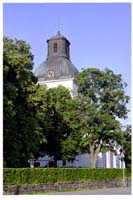 18th
century
18th
century
Ovansjö church, from the 13th century, was considered too small and was rebuilt. The new church was consecrated in 1763. Some parts of the first church still remain intact. In the porch of the new church, where visitors had to leave their swords and other weapons before entering, a unique rune stone with runic inscription can be seen. The Vicarage and surrounding areas of "Åsen" was during many centuries the central administrative- and religious region.
The villages of Ovansjö consisted of cultivated land, fields, forests, swamp land, farms, rivers and lakes. In spite of the number of rock men being reduced, the inhabitants in Ovansjö were never forced to leave the county and look for jobs. On the contrary due to rich, local resources workers from other counties such as Dalarna arrived here to make a living.
Following the industrial revolution during the later part of the 18th century, larger enterprises were formed. This period was in Sweden called "the death of the works". Ovansjö, however, still remained a central region. The village of Kungsgården was situated were the roads from Torsåker and Svärdsjö joined. The district court sessions were held at "Sandbacka" in Kungsgården between 1782-1881. People from Torsåker, Årsunda and Ovansjö gathered here for the Assizes. The court house, which was inaugurated 1782, was later used as the banking house for the parish of Ovansjö. The building still remains and is at present held as an antiques shop.
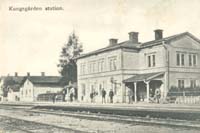 19th
century
19th
century
In the 19th century a saw mill and a rolling mill could be found in Kungsgården.
The construction of a new railway line between the towns Gävle and Falun commenced in Gävle 1855. The Gävle-Dala railway was ready for use in 1859. It was opened for regular service in 1887 and train stopped at the railway station in Kungsgården (left). The station has since been demolished.
The parish of Ovansjö had its first library set up in 1860. A senior master in Stockholm, Mr Z Göransson, born at the Per-Ers farm in Åsen, Kungsgården sponsored the village for purchasing books. Library statutes were not made up until 1875 however and that year does therefore count as the birth year for libraries. The library was opened in the parish house along the main road Ovansjövägen and the building is today used for the weaving society. The library was first moved to "Haglöw's house" next to Rosenlöf's printing museum and the council house. Until to November 2006, the library could be found in one of the school buildings at the address Korsikavägen 1. That library is now only open for school access and the nearest library is located in Sandviken.
Between
1861-1894 506 inhabitants emigrated from Ovansjö to North America.
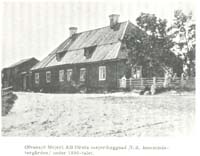
A dairy, Ovansjö Mejeri AB, was built in 1891. The dairy was one of the first companies belonging to the producer's co-operation in the region (right).
At the end of the 19th century, the brothers Rosenlöf opened a printing works house were e.g. office books were printed.
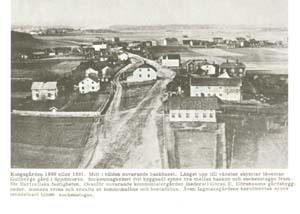 20th
century
20th
century
By 1900 no foundry, smithy of iron works was to be found in the area. Forest was planted on the soil that was poor and difficult to cultivate. The timber was sent to the saw- and pulp mills. The rivers and streams were important motive powers for watermills and turbines. A few sawmills and mills were situated at the waterfalls, for example the Norrberg and Åttersta sawmills. The latter is still operated privately. The soil, which was still left for planting grain was part of the best in the county. Horses were no longer used as draught animals. Ovansjö Machinery bought the first combined harvester in 1948.
The poor and elderly in Kungsgården
During
the middle ages the poor and others in need were cared for in hospitals
and sanctuaries. The farmers distributed parts of the grain to people
in need, but at the end of the middle ages the responsibility was laid
upon the church. Poor people were given "beggar passports" by
the priesthood. It was common to place week, elderly people and children
with others, who were given a small contribution to keep them alive. The
need for a house where poor and old citizen could be kept grew. At the
end of the 18th century, one of these houses was built in Kungsgården
in the park where the Vasa memorial stone can be found today. More houses
were built for this purpose and there were smaller cottages in the villages
where they could live. The poor peoples house in Kungsgården was
never repaired or looked after and in the mid 1850th it was no longer
in use. The parish needed a new house to lodge people in need and a committee
was formed for the purpose in 1882. 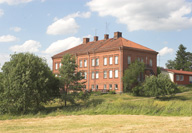 In
1885 the large building "Backberg no 1" (picture to the left)
was bought and the boarders were kept in the mansion building. The inmates
had to work for their living. One of their duties was to bring a saw and
an axe and walk to the school's woodshed and cut wood for heating the
school. The poor peoples house also operated a self supporting farm. The
mansion building has since been used for care of the aged, but was transformed
and operated in a modern way.
In
1885 the large building "Backberg no 1" (picture to the left)
was bought and the boarders were kept in the mansion building. The inmates
had to work for their living. One of their duties was to bring a saw and
an axe and walk to the school's woodshed and cut wood for heating the
school. The poor peoples house also operated a self supporting farm. The
mansion building has since been used for care of the aged, but was transformed
and operated in a modern way.
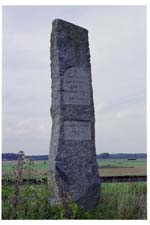 Sturestenen
- the Sture stone
Sturestenen
- the Sture stone
Two memorial stones, which reminds of war times can be found in Ovansjö. One of them is "Sturestenen", the Sture stone, which was erected 1928 at Syltebron between the villages Övermyra and Mom. One of the legends tells that the battle of Syltbäcken, "the Jam stream", was held here against the Danish during the reign of Sten Sture in the 1500th century. Legend has it that the name "the Jam stream" comes from the Danes being thrown into the stream and so jamming it that the water was coloured with blood. This legend also tells that the area of Flyktsbacka "the Hillside escape" was so named following the Danish fighters escaping up the hill. Another legend tells about a battle between the archbishop Jöns Oxensterna, an ally of the Danes and the loyal Karl Knutsson Bonde in the 15th century. The nearest translation of the inscription on the stone reads: "Here, in the district of the iron, defended oneself in times past the people of the land against foreign intruders. Under obligation to the memory. Spjutmuren. Flyktsbacka. The stone was erected 1928."
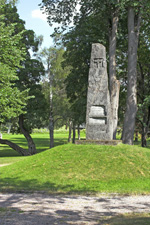 Vasastenen
- the Vasa stone
Vasastenen
- the Vasa stone
King Gustaf Vasa visited Ovansjö in April 1521. He gathered the people around him by the church. The king wanted the people of Gästrikland to join him and fight against the Danish king's warriors. The memorial stone Vasastenen, the Vasa stone, was 400 years later erected in the memory of the king's visit and can be seen in the park to the east of Ovansjö church. The nearest translation of the inscription on the stone reads: "In April 1521 did in Ovansjö, the people of Gästrikland meet with Gustaf Eriksson Vasa and joined his battle for the freedom of Sweden.
Read more about: